What is at stake is our collective wellbeing
Valentina Karga
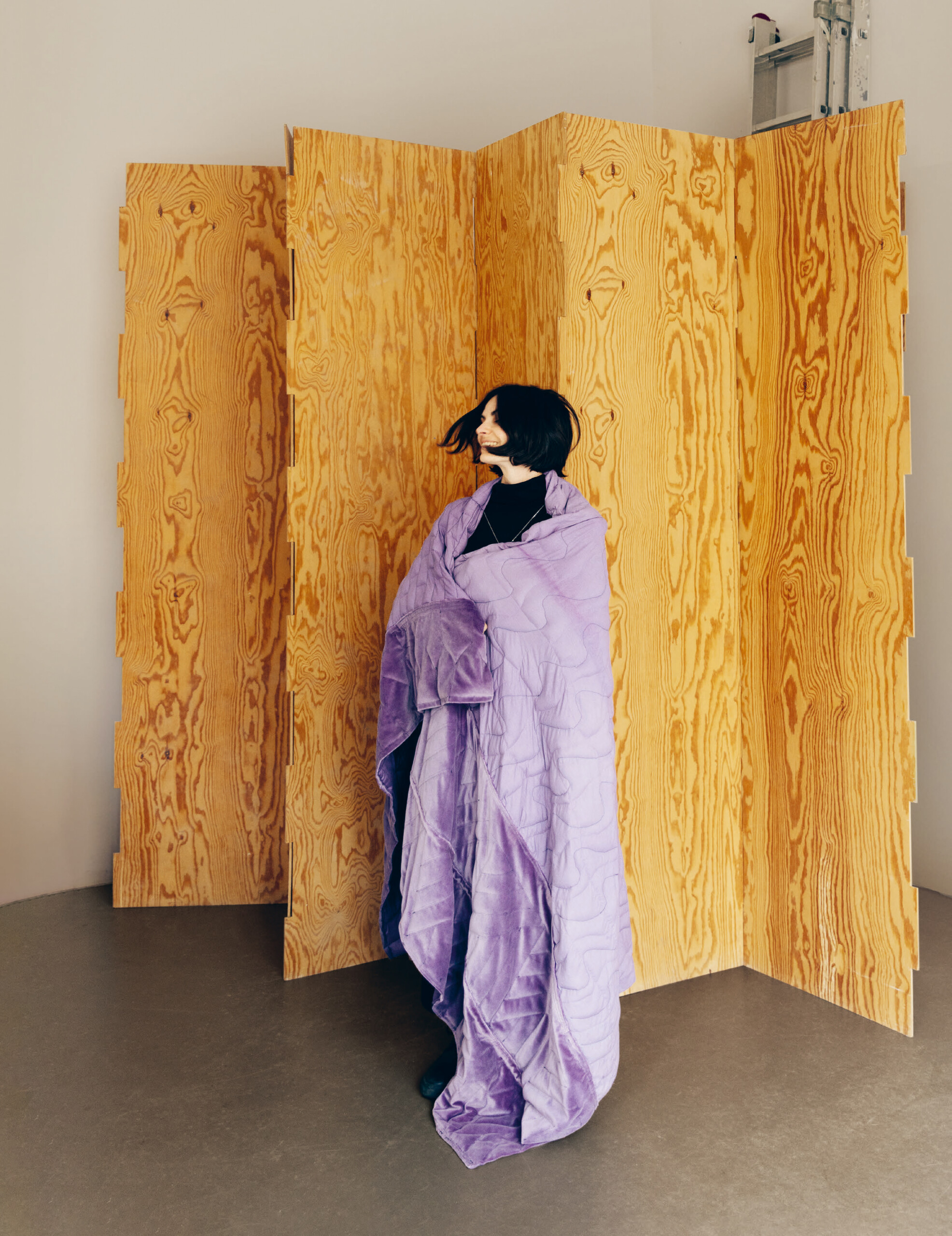


Greek-born Valentina Karga is currently installing her solo exhibition, Well Beings, in the Museum für Kunst und Gewerbe (MK&G) in Hamburg, where a flock of soft creatures awaits us to be touched and embraced, among them a human-sized plush figurine, body warmers with features that resemble eyes and hug pillows shaped to be held close to our body. Her usable sculptures invite us to explore our fears and worries with regard to climate change. An architect by training, Valentina creates works that draw on the investigative potential of art as well as the applied nature of design, and carve out a socially engaged practice based on research, speculation and collaboration.
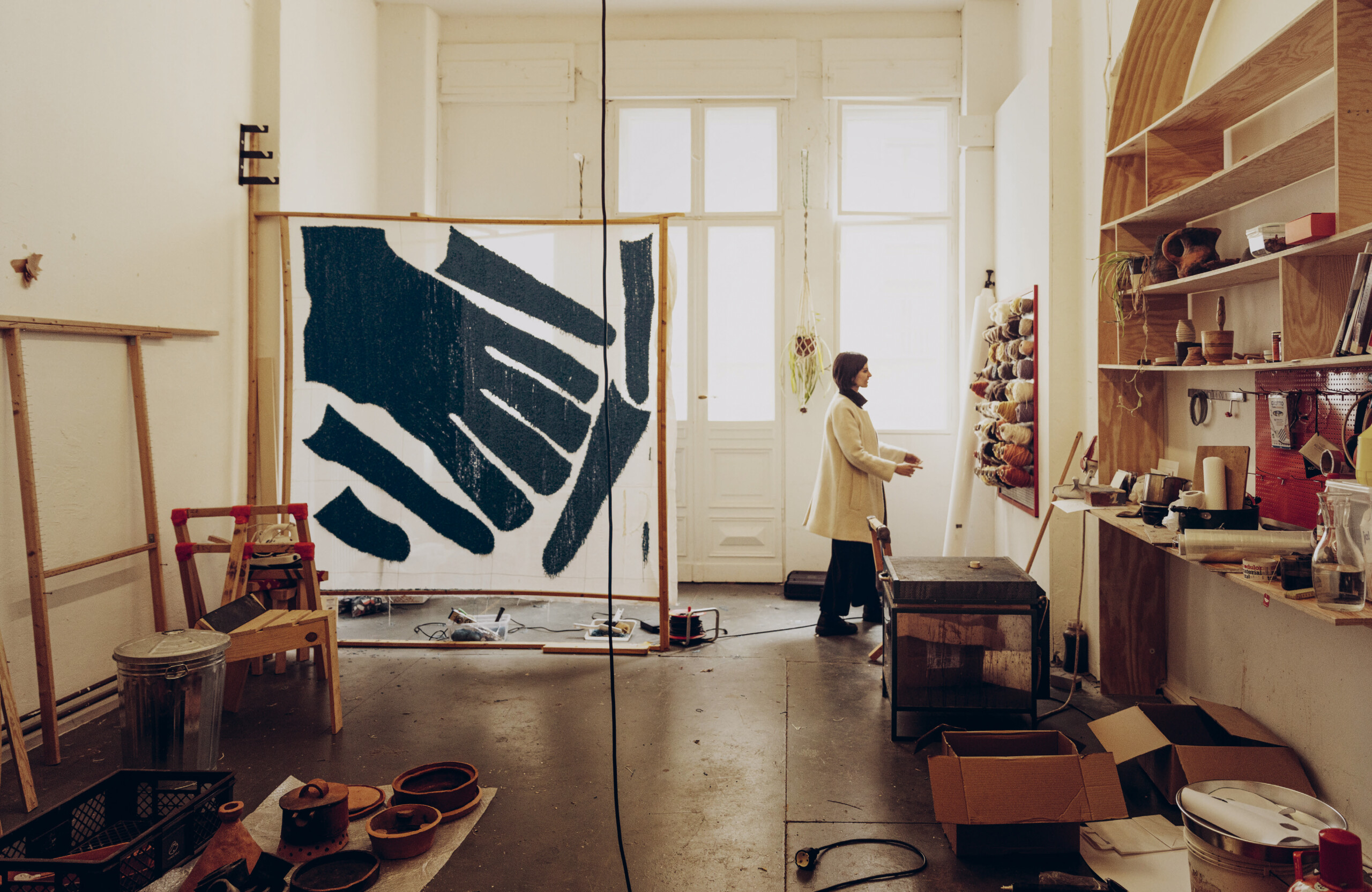
Her work is widely recognised. She was selected for the renowned Vilém Flusser Residency Programme for Artistic Research and has been Professor for Introduction of Artistic Work in Design at the Hamburg University of Fine Arts since 2018. We catch Valentina in her studio, which she shares with the product designer Axel Kufus in Berlin Schöneberg. The former gallery has large windows onto the street and provides glimpses of its interior to occasional passers-by. We talk to her about how climate anxiety is becoming a vehicle in her work for discussing the wider question of how we can live well together in our current age of uncertain futures.

The exhibition Well Beings by Valentina Karga, in the Museum für Kunst und Gewerbe (MK&G) in Hamburg, runs to 3 September 2023.
Valentina, for your Well Beings exhibition in Hamburg, you have produced a new body of work which investigates the phenomenon of eco-anxiety and proposes strategies from art and design to cope with it. Eco-anxiety is the chronic fear of environmental collapse in the context of climate change and species extinction, which is increasingly recognised and studied as a condition that—affects more and more people worldwide. Can you tell us how eco-anxiety affects people?
V
K
Eco-anxiety, or climate anxiety as I like to call it, registers as a spectrum of emotions. The loss of biodiversity, for instance, may cause sorrow and distress. We are grieving for the lost species that we’ve been sharing this planet with, and we feel angry and helpless at the fact that mitigation measures seem to be ineffective and that we as individuals can do very little about it. At the same time, there is fear and concern about the future regarding our wellbeing and that of other people who live in countries that are likely to become unliveable. As a result, we will witness intensified climate migrations. The question of whether our states will open the borders to these people or lock them out will become ever more urgent. This causes anxiety, but also guilt for those of us who live in the privileged Global North. What is at stake here is collective wellbeing. I’m less afraid for myself, but what frightens me is the imminent loss of other species—including other humans. What will this bring? How will we negotiate who gets the remaining resources and access to land that can still be lived on? Unless we process these feelings of climate anxiety, panic and fear will prevail, and we risk taking a lot of bad decisions that create further harm.
-
-
-
-
You have experienced climate anxiety yourself. How do these emotions register?
V
K
Everybody is very different, and it can be so many different things really. It can cause nervousness, the sensation of suffocation, sleep disturbances, panic attacks and depression. Anxiety and depression as they are commonly known cannot provide an adequate understanding of what eco-anxiety involves. While cognitive behavioural therapy aims at healing anxiety through changes in behaviour, these techniques do not work in the case of climate anxiety. You can only do so much to make yourself feel better—by carefully selecting which products to buy, by flying as little as possible—but this has still very little impact. And it’s not about that really, it’s about how you manage to communicate with and accept your emotions. And I learnt that emotions are always embodied. It’s not just a worry in my head, it manifests as a knot in my throat. It feels as if I cannot speak up or swallow. Other people have a closure or a heavy weight in their heart. I had periods during which I was so anxious that I could not sleep. In the beginning I couldn’t understand what it was, because everything in my life seemed good and balanced. I didn’t have any personal reason to worry. But then I dove into it and I found out that this condition exists and that other people experience it, too, so I’m not alone.
-
-
-
-
There has been concern about environmental degradation and its effects since the 1970s. In what way is eco-anxiety different?
V
K
Scientists like the environmental theologist Panu Pihkala are attesting a new quality to today’s climate fears. It has been recognised that unlimited access to negative news about the climate crisis may cause and intensify eco-anxiety. Take doomscrolling for example; when you start looking at bad news on social media or any other online platform, the algorithm is trained to give you more of that. When I started looking at climate news, it kept coming up on my feed. Its disproportionate focus on disaster can make you feel bad. Good news such as efforts towards climate mitigation hardly ever comes up during scrolling. I wanted this experience to be present in the exhibition, so I made a Doomscroll video, which is displayed on a large screen resembling an oversized smartphone. Even though the Doomscroll video might trigger anxiety, I felt that it is an important element shaping our contemporary reality and therefore could not be left out.
-
-
-
-
What kind of strategies do you propose in the exhibition to address eco-anxiety?
V
K
When I was going through the different anxiety phases myself, I searched on the internet for ways to cope. And again, the algorithms started to give me self-care products that are promoted as remedies. There’s a whole market of stuff nowadays—from weighted blankets to body warmers, from hug pillows to plush toys. I bought myself a weighted blanket that is filled with sand or glass beads and weighs more than a normal blanket—mine is around seven kilos, which has been calculated according to my weight. It feels really nice, a little bit like a hug, and it’s supposed to work with acupressure to promote relaxation. Anxiety affects our nervous system and can trigger three different responses—fight, flight and freeze. My climate anxiety, for instance, triggers the flight mode in me. That’s why it’s sometimes hard to get out of bodily anxiety because the nervous system gets stuck. No matter how much you address your brain, you have to go through the body. When you have a heavy blanket above you, it sends calming signals to your body and you feel protected, which in turn makes you sleep better. Another thing that helped me are body warmers. They function like a hot water bottle, but are filled with natural seeds, such as grape seeds, and can be heated in a microwave. Their loose fit accommodates the shape of your body. Heat can soothe physical pain, like the knot in my throat. When I set out to create the exhibition, I made a series of objects that were inspired by these existing product types. Given the context of a design museum, I liked the idea that my sculptures are modelled on objects that have been designed to be used, and I invite visitors to touch and embrace what I call usable sculptures. In addition to the weighted blanket and several body warmers, I made a Hug Sofa with pillows that you can pile onto yourself, and plush toys, because it helps not only to feel hugged, but also to hug something—even if it’s not a living thing.
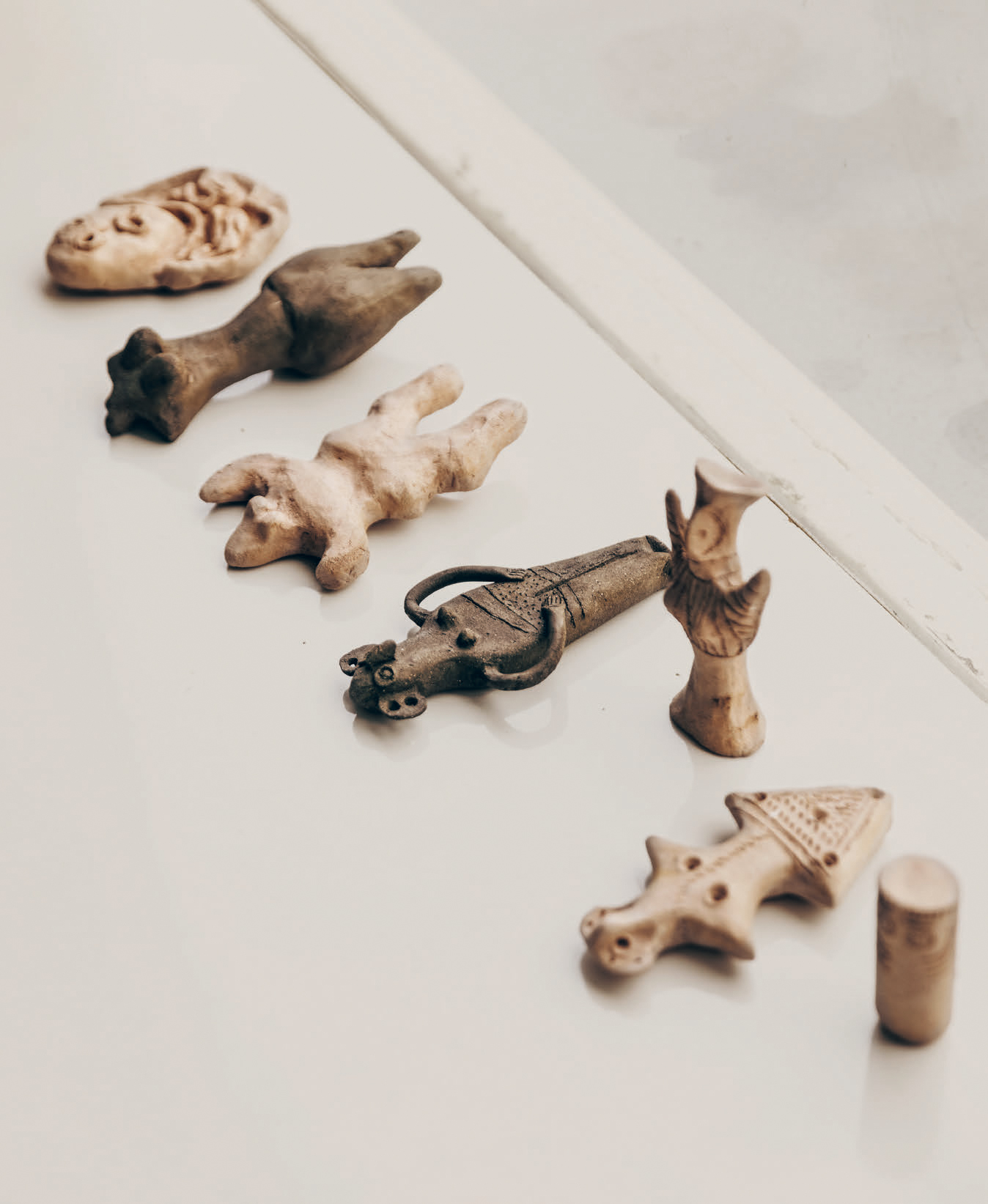

Valentina Karga is fascinated by prehistoric figurines. With their animal-like quality and anthropomorphic shapes, they seem to be hybrids between humans and non-humans. In her exhibition, the Greek artist proposes that they may inspire new and more beneficial perspectives on our relationship to other beings.
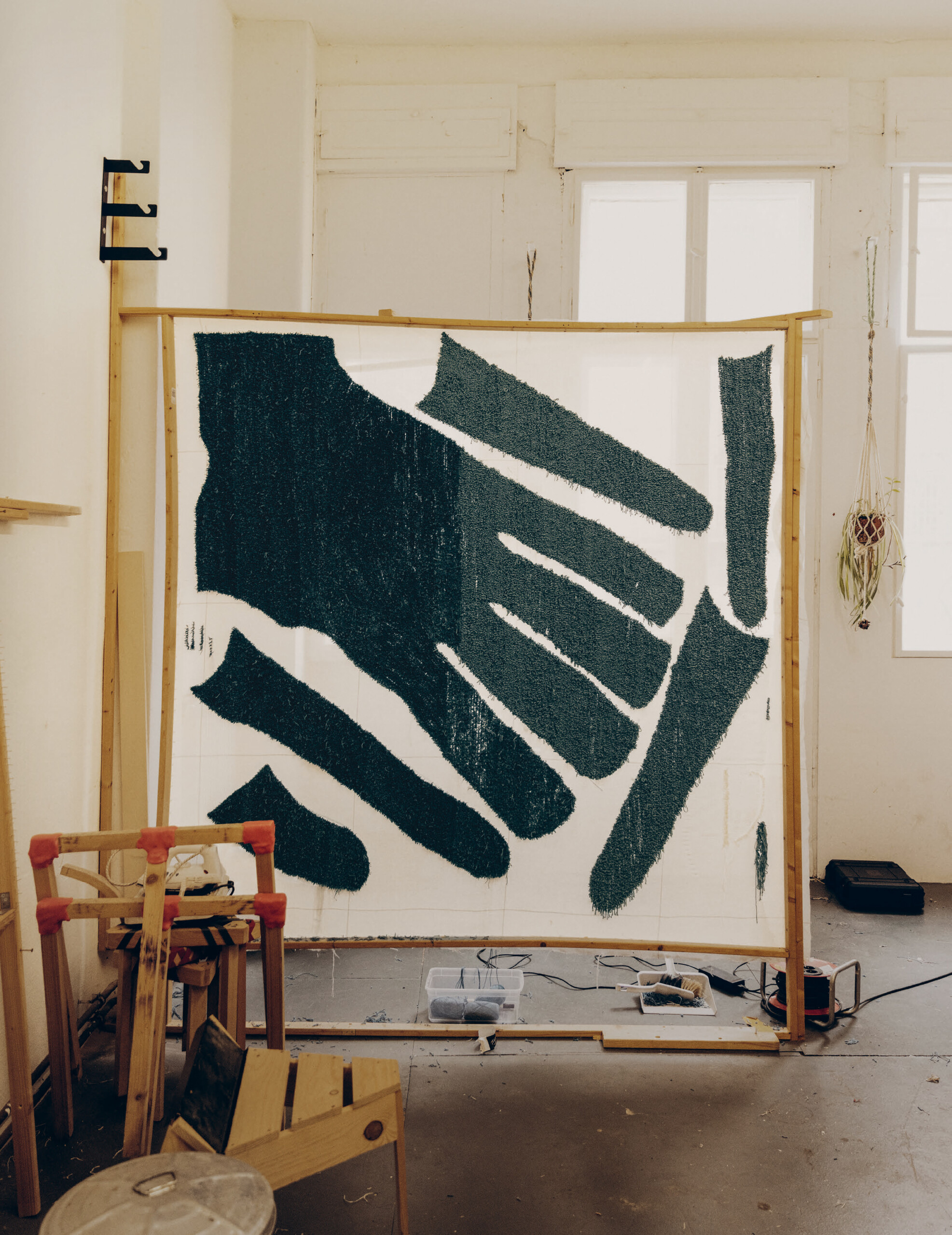

How about the process and the materials you mentioned?
V
K
I tried to produce everything in ways that would have as little ecological impact as possible so that it would not give me too much stress. While I would have loved to design a new sofa, for instance, I got an old sofa and we worked with a professional upholsterer to re-upholster it in a natural cotton fabric. I dyed this and all the other fabrics in my studio using natural dyes for which I collected a lot of the plants myself, such as madder and eucalyptus leaves. For the sofa filling, I used wool which would have otherwise been discarded because of its poor quality. So apart from the reused sofa foam, everything is compostable. I don’t believe that art should last forever. In my practice, I aim at closing the material cycle. I like to make it easy for the earth to digest the materials that I’m using. Ultimately all materials are natural, even plastics. They, too, come out of the earth, but then we trap them by engineering them into forms that are so closed that they cannot return to the cycle, or at least not in a timescale that will not outlive us and other living organisms.
-
-
-
-
With regard to the stuffed animals which are commonly used in therapy, you have said that they can involuntarily trigger eco-anxiety. Why is that? And how did this impact your work?
V
K
They can, because they make you think even more about the impending extinction of many species. Instead of referencing particular animals, I looked to prehistoric idols for inspiration, which I love for their beautiful craftsmanship. It was a lucky coincidence that the MK&G has some of these idols in its Antiquities Collection—prehistoric figures of abstract creatures, made of marble and clay and dating from 2000 years BCE and younger. These figurines are what give form to the exhibition. The Hug Sofa and the other soft objects I created are blown-up versions of them, which I then shaped in line with the typologies of the self-care products mentioned before. I have long been interested in these idols because prehistory is such a speculative field. Since there are no written records, nobody can be really sure what these idols were used for. In their recent book, The Dawn of Everything, anthropologist David Graeber and archaeologist David Wengrow write that these figures were actually not found in the most sacred spaces, but in trash dumps outside houses. This supports the assumption that contrary to what had been thought, they were not very precious after all, but had more mundane functions. Of course, this is all speculation. I’m not really interested in figuring out what they were actually used for, either, but in thinking of what we can use them for today. They have this animal-like quality, they often look like birds or butterflies or snakes, but they are also anthropomorphic—they have faces, arms and sometimes legs. They are hybrids between humans and non-humans. And since we are talking about healing the body but also changing the mentality we are thinking from, and we’re talking about going back to animal instincts like fight, flight and freeze, I am actually even grateful to my anxiety because it made me understand that I’m still an animal in many ways. This is what those figures represent to me.
-
-
-
-
Are you suggesting that these prehistoric idols can teach us something about ourselves today? If so, what clues may they hold for us?
V
K
Yes, that is exactly what I’m trying to say with this exhibition. And that is why archaeology is such a fascinating science for me, because it looks through the past into one of the most interesting questions: What does it mean to be human—and how did people understand themselves as humans? I was reading the work of the Lithuanian archaeologist, Marija Gimbutas, who excavated many of these figurines from the Neolithic period in the 1970s. I actually knew her from Greece because the Archaeological Museum in Volos, the city where I studied, is full of these figurines and she was the leading archaeologist who discovered them there. Most of them have female characteristics like breasts, and she interpreted them as earth goddesses and symbols of a lost matrilineal era in prehistoric Europe. In the context of the second wave of feminism, her work was seen as ground-breaking, but she was also highly discredited by fellow archaeologists who disputed her findings. When we read her work today with Bruno Latour’s revisitation of the Gaia Hypothesis and other contemporary writing in mind, we have a very different context. To me, these prehistoric idols look like natural beings with a hybrid quality beyond fixed categories of the human or the animal. They may recall that the other is not external to us, but that we ourselves are also others—be it as animals, be it as women, be it as people of colour, be it as people of different genders or non-gender-specific. To me, these prehistoric idols are symbols of a more-than-human world that tell us something about our relation with nature. They can help us to overcome the nature-culture divide, which has dominated Western thinking for so long and is still performative, and which can be seen as an underlying cause for eco anxiety. If we start to understand that nature is not external to us but we are part of it, this can open up new perspectives on our relationship to other beings and to the earth as habitat, and thereby provide consolation and comfort.
-
-
-
-

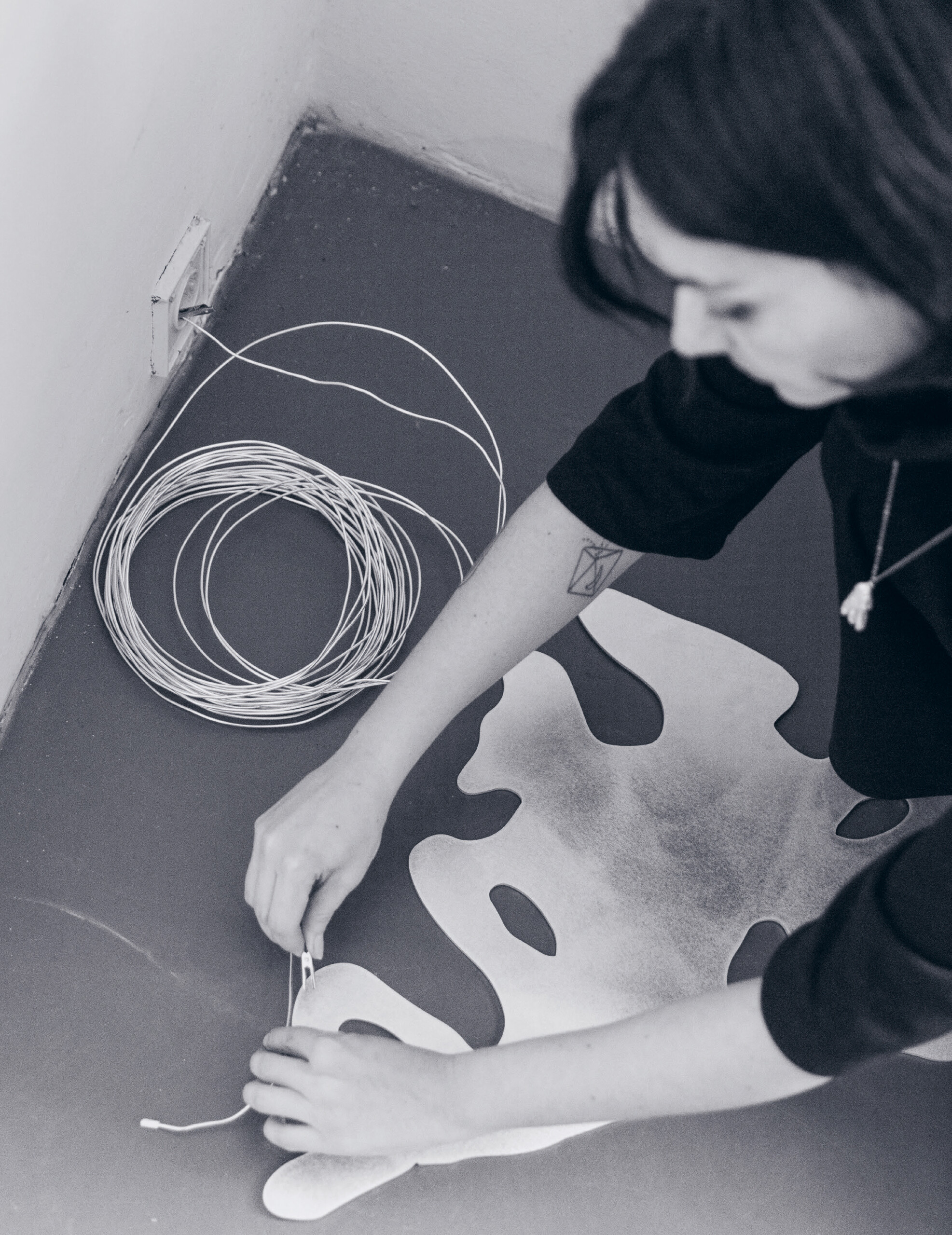
Valentina Karga in her studio in Berlin. The former gallery space is seemingly animated by a host of organic shapes and strange creatures rendered in different materials and dimensions.
Should climate anxiety perhaps be seen less as an individual condition, but rather as a phenomenon with a diagnostic potential for wider societal issues?
V
K
I perfectly agree. We’ve been trained that we are responsible for our own well-being and that it’s nobody else’s business. Still, a lot of the issues that people are suffering from today are systemically woven into the social-political sphere, but this link remains largely obscured. And I think mental health problems have skyrocketed in numbers. We live in a very complex world that is profoundly changing. There is a lot of resistance to these changes, but we don’t talk enough about our worries and fears. Think of the history of mental health and how hysteria, anxiety and depression have been attributed to women—that’s where the taboo comes from. And it’s time to dismantle it. Isn’t it immensely sad that we still live in a culture that denies our feelings, that alienates us from ourselves and thereby contributes to the suffering?
-
-
-
-
What is the link between the weighted blankets and hug pillows on the one hand, and the anger and activism at the Fridays for Future manifestations on the other? And is cuddling up at home a passive response compared to protesting in the streets?
V
K
I think both are valid responses to climate anxiety. It comes back to what we were saying in the beginning. Climate anxiety contains a spectrum of emotions, and it’s not just anger. On some days, you may need the blanket and stay at home. On others, you take to the streets and celebrate your anger. While I find these objects interesting and some of them even helpful, I’m also critical towards them. I don’t present them as the answer, but discuss them as a solution that design offers in coping with these feelings. Design is implicit in capitalism. As capitalism advances, new emotional states of being emerge. In response to them, we create novel objects that address our emotional needs, but in turn distract us from the origin of the problem and actually add to it even further by contributing to yet more consumption. I think we suffer from climate anxiety in part because of this capitalist paradox. What I try to do in the exhibition is to display the state where we are now. The market that produces the anxiety-triggering doomscroll algorithm is the same that produces the weighted blankets to help us cope with it. For me, these are all props to help me frame the question: Should this market of self-care products exist at all? Or should we go to the demos and hug each other there? I don’t really have an answer, and it is not my aim to take a black-and-white stance for or against. However, I often work collaboratively with other people, and I co-created a collaborative piece for Well Beings: the film Adaptation, together with choreographer Polyxeni Angelidou and live action role-play (LARP) designer Nina Runa Essendrop, students from the Hamburg University of Fine Arts, costume designer För Künkel, and Junya Fugita, who made the sound. LARP is a great immaterial tool for negotiating and understanding feelings, and the collective experience of conceiving and producing the film restored me a little to my usual self. A self that finds solace in being together.
-
-
-
-
Thank you, Valentina, for taking us on this journey.
